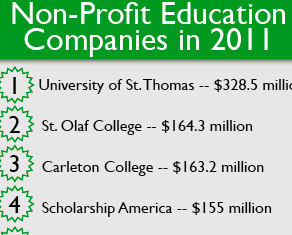Discussions for St. Thomas’ 2014 fiscal budget are in the works and when the St. Thomas Board of Trustees approves the university’s 2013-2014 budget on Feb. 14, revenue is expected to increase in the 2014 fiscal year.
Should this happen, St. Thomas would remain, as it has in previous years, the highest revenue among all Minnesota private colleges.
St. Thomas was ranked first in the education category for the amount of revenue it brought during the 2011 fiscal year on the Star Tribune’s 17th annual top 100 Minnesota nonprofit organization list released late-December.
The university ranked 16th on the overall list and with a revenue of $328.5 million, it ranked above any other private educational institution in Minnesota and showed a 16.4 percent increase from 2010’s revenue of $282.4 million.
St. Thomas also received the No. 1-ranking in the education category for the university’s 2011 expenses, which totaled $302.4 million.
Topping the yearly list is nothing new for St. Thomas. Doug Hennes, vice president of university and government relations, said that in his 22 years with the university, he couldn’t remember a time when St. Thomas didn’t sit at No. 1 or No. 2 on the list.
“The one that on a couple of occasions has been rated higher than us is Northstar Education Finance, a loan company. But their numbers have fallen off quite a bit in the last few years,” Hennes said. “Aside from that, we’ve always been No. 1, which makes sense because we’ve been, by far, the largest institution.”
In fact, St. Thomas stands far above the rest on the education list, with its revenue nearly double the next highest institution. St. Olaf College and Carleton College stand at No. 2 and No. 3 on the list, respectively, with St. Olaf’s revenue at $164.3 million and Carleton’s at $163.2 million.
“I think largely, it’s a matter of size. We’re two to three times the size of most other schools,” Hennes said. “I think the higher revenue numbers are reflective of both our larger size, and our success at raising funds, too.”
Senior William Strand said he thinks St. Thomas’ exposure and location could help the university bring in revenue.
“I definitely hear more about St. Thomas than I do other schools. We’re in the heart of the city here, and we’re very much in the public eye,” Strand said.
The majority of the university’s revenue is made up of tuition and room and board, contributions, and investment income, Hennes said. He also said the yearly decision to raise tuition costs plays a large role in increasing revenue, but it is not a decision that is taken lightly.
“We’re always mindful of the cost of a higher education and we do everything we can to keep our price increases from year to year minimal, as well as trying to put more money into financial aid,” Hennes said.
While increasing tuition can be painful for students, Hennes said it is a necessary part of keeping the university functioning to its highest standards.
“We really do try to scrub our budget and keep costs as low as possible, but we also want to provide salary increases, and we have some fixed costs that are going to go up every year like utilities, and things like that,” Hennes said.
Sophomore Kristen Bastug said while she doesn’t believe St. Thomas’ high revenue necessarily means more financial help for students, attending a successful school could be beneficial.
“As students, I don’t know that (the revenue) gives any relief financially for us, but I think going to a school (that brings in a good revenue), the atmosphere would definitely be a little better than a school that doesn’t,” Bastug said.
Strand said having high revenue at a private college could bring added opportunities for students.
“When it’s a private school, you know the money is going right to the college, and that can provide a lot of unique opportunities that a publicly funded university might not have,” Strand said.
Hennes said while the numbers appear to show that the university had $328.5 million to spend in 2011, and the expense shows a $302.4 million deduction, that isn’t necessarily a true reflection of what was spent.
While some of the contributions and investment income are reported as revenue, the money is not necessarily ready to be spent. Some of the contributions are put towards endowments or are pledges that cannot be spent in a given fiscal year. Most of the income earned off of investments comes from endowments, and the majority of the profits are used to grow the endowment, rather than spent.
Hennes said the actual “spendable” revenue typically comes close to matching the university’s yearly expenses.
“Typically, year to year, when it comes to money in the door and money that goes out the door, we come pretty close to a balanced budget,” Hennes said.
As for future budgets, Hennes said the board is still working numbers, but increasing revenue is always the goal.
“We’re still working with the numbers, and we haven’t set a tuition increase yet,” Hennes said. “I would expect revenue will be higher, but of course, expenses will be higher too.”
Gabrielle Martinson can be reached at mart5649@stthomas.edu.


